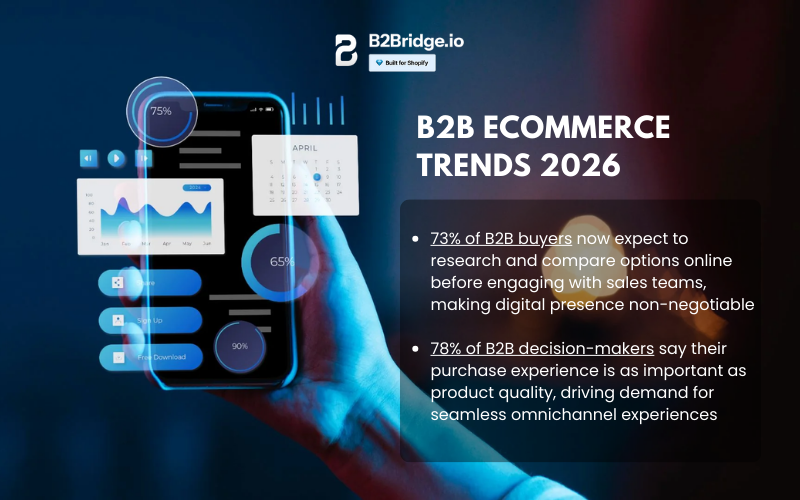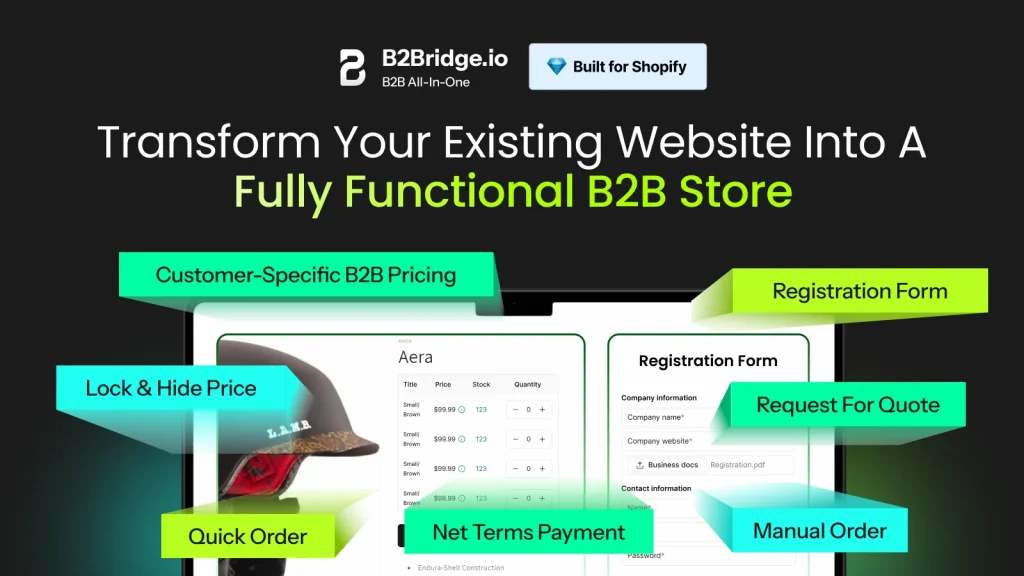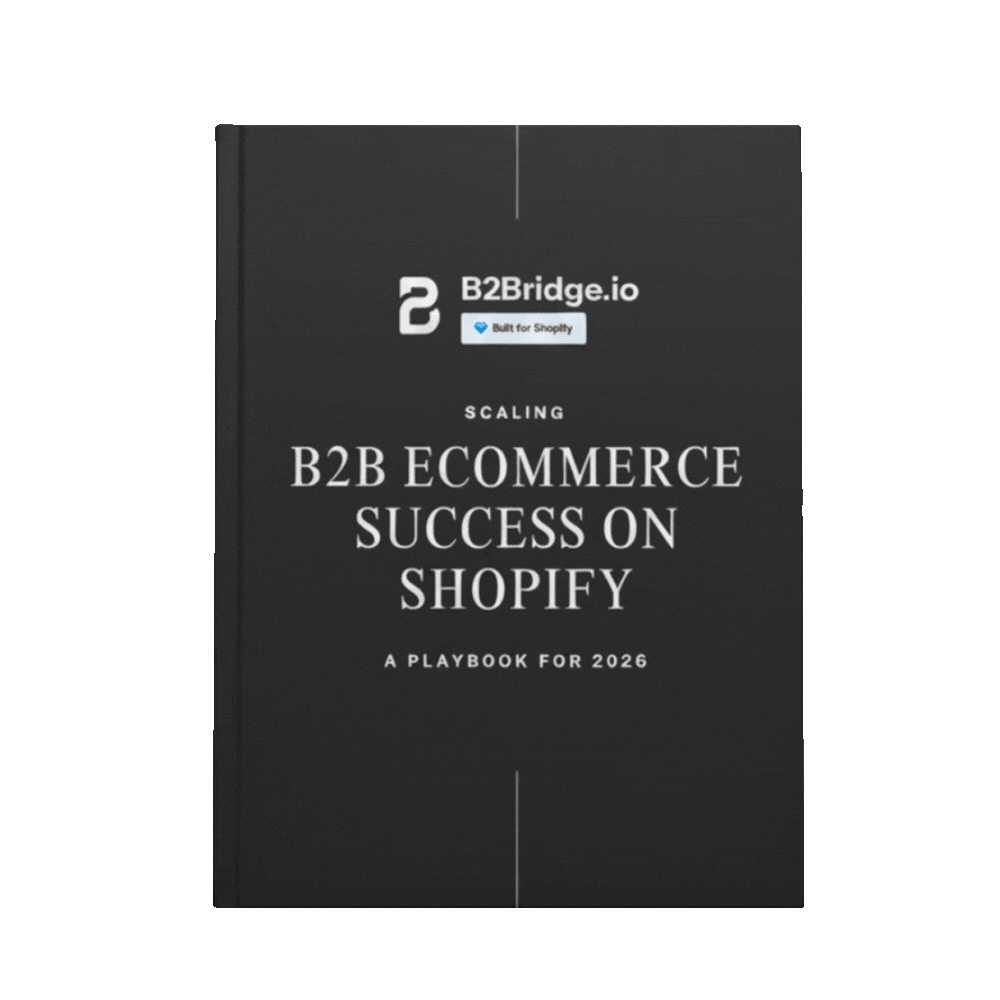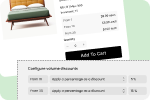Key B2B Ecommerce features include custom pricing, advanced account management with user roles, and flexible payment terms to support complex transactions. Additional must-haves are bulk ordering, self-service customer portals, seamless ERP/CRM integrations, strong analytics, and enterprise-grade security.
This guide explores the 10 essential B2B Ecommerce features that separate thriving wholesale businesses from those struggling to keep pace. Whether you’re launching your first B2B channel or optimizing an existing platform, these capabilities will help you reduce friction, increase efficiency, and build lasting buyer relationships.

What is B2B Ecommerce?
B2B Ecommerce refers to the digital buying and selling of goods and services between businesses rather than between a business and individual consumers. While it shares some similarities with B2C transactions, B2B Ecommerce operates under fundamentally different dynamics.
The B2B Ecommerce landscape is experiencing unprecedented growth. With the global market projected to reach $36 trillion by 2026 and growing at a 14.5% CAGR, dealers and wholesalers who invest in the right digital infrastructure today are positioning themselves for tomorrow’s success.

>> B2B Ecommerce Features: 10 Must-Have Features For Dealers & Wholesalers
But here’s the challenge: B2B Ecommerce isn’t simply B2C with bigger orders. Your wholesale buyers navigate complex purchasing journeys involving multiple decision-makers, negotiated contracts, and unique payment requirements. The average B2B purchase involves more than eight stakeholders, and buyers now expect the seamless, personalized experiences they enjoy as consumers.
Consider the complexities: wholesale orders typically involve larger quantities, higher values, and extended payment terms. Pricing varies by customer, contract, and volume. Multiple stakeholders within a buying organization may need to review, approve, and track orders. And unlike impulse consumer purchases, B2B buying decisions are driven by logic, ROI calculations, and long-term relationship considerations.
These distinctions mean that repurposing a B2C platform for wholesale operations creates gaps that quickly become pain points. A true B2B Ecommerce solution addresses the unique workflows, pricing structures, and relationship dynamics that define business-to-business commerce.
Essential B2B Ecommerce Features For Your B2B Store
1. Advanced Product Catalogs and Dynamic Pricing
At the heart of effective B2B Ecommerce lies the ability to present the right products at the right prices to each customer. Unlike retail, where everyone sees identical listings, wholesale operations require sophisticated catalog and pricing management.
Personalized catalog views ensure buyers only see products they’re authorized to purchase. This might mean exclusive product lines for key accounts, regional restrictions on certain items, or contract-specific inventory access. When a buyer logs in, they should immediately find relevant products without wading through irrelevant SKUs.

Dynamic pricing engines automatically apply the correct rates based on customer tier, contract terms, volume thresholds, and promotional rules. This eliminates manual price lookups and reduces errors while supporting strategies like:
- Tiered volume discounts that reward larger purchases
- Customer-specific contract pricing negotiated with key accounts
- Percentage-off or fixed-price structures based on account type
- Maximum and minimum order quantities per product
AI-powered search further enhances product discovery by understanding industry terminology, matching manufacturer part numbers, and suggesting alternatives when items are unavailable. The goal is reducing the time between a buyer recognizing a need and placing an order.
B2Bridge Tip: With B2Bridge’s price list management, you can create unlimited customer-specific pricing tiers and automate volume discounts – showing the right price to the right customer every time while hiding wholesale rates from retail shoppers.
2. Mobile-First Experience and Progressive Web Apps
Your field representatives and buyers aren’t always at their desks. Modern B2B commerce happens in warehouses, at trade shows, during site visits, and between meetings. Mobile accessibility isn’t optional – it’s essential.
A mobile-first B2B platform delivers:
- Responsive interfaces that adapt to any screen size without losing functionality
- Offline capabilities through progressive web apps, allowing order entry even without connectivity
- Fast-loading pages that don’t frustrate users on cellular networks
- Touch-optimized navigation designed for how people actually use phones and tablets
For sales representatives, mobile order-taking apps connected to your central system enable real-time access to inventory levels, customer-specific pricing, and order history. Orders placed in the field sync automatically with your ERP and Ecommerce platform, eliminating duplicate entry and the errors that come with it.

Consider that buyers increasingly research products on mobile devices before purchasing. If your wholesale portal delivers a clunky mobile experience, you’re creating unnecessary friction at a critical point in the buying jour
ney.
B2Bridge Tip: B2Bridge works seamlessly across all devices, ensuring your wholesale buyers enjoy the same smooth experience whether ordering from desktop, tablet, or smartphone – no separate app required.
3. Self-Service Customer Portals
Today’s B2B buyers want autonomy. They don’t want to call a sales representative to check order status, request a copy of an invoice, or reorder products they’ve purchased before. Self-service portals address these expectations while freeing your team for higher-value activities.
Effective self-service portals enable buyers to:
- Browse personalized catalogs and access account-specific pricing
- Place new orders and quickly reorder from purchase history
- Track shipments and view delivery timelines
- Download invoices, statements, and order confirmations
- Update shipping addresses and contact information
- Manage multiple users with role-based permissions
The key is integration. Your self-service portal should reflect the same data your internal systems use. When a buyer checks inventory or views their account terms, they should see accurate, real-time information that matches what your sales team sees.
This level of transparency builds trust. Buyers appreciate the convenience of 24/7 access, and your operations team spends less time fielding routine inquiries.
>> Read more: Inventory Management: Definition, Benefits, Formula, Techniques & Examples
B2Bridge Tip: Give your B2B buyers a smooth, self-serve shopping journey with B2Bridge’s customer portal. Buyers can view their custom pricing, reorder with ease, and manage their accounts independently – reducing support requests while increasing satisfaction.
4. Intelligent Search and Product Discovery
When your catalog contains thousands of SKUs across multiple categories, finding the right product quickly becomes critical. Poor search functionality frustrates buyers and leads to abandoned sessions or orders placed for incorrect items.
Intelligent B2B search goes beyond basic keyword matching to understand how your customers actually look for products:
Faceted filtering customized to your industry allows buyers to narrow results by specifications that matter – dimensions, materials, compatibility, certifications, or any attribute relevant to your products. A plumbing supply wholesaler needs different filters than an electronics distributor.
Part number matching handles the messy reality of B2B product identification. Your search should recognize manufacturer part numbers, strip out special characters, and cross-reference competitor part numbers when buyers use different naming conventions.
AI-powered recommendations surface relevant products based on purchase history, browsing behavior, and what similar customers buy. These suggestions support upselling opportunities and help buyers discover products they might have missed.
Contextual personalization adjusts results based on who’s searching. A buyer’s industry, role, contract terms, and past orders should all influence what appears first in their search results.
The goal is reducing friction. Every extra click or scroll between a buyer and the product they need represents an opportunity for frustration or abandonment.
B2Bridge Tip: B2Bridge enhances your Shopify store’s native search with B2B-specific filters and customer-aware results, helping wholesale buyers find exactly what they need within their personalized catalog and pricing tier.
5. Workflow Automation and Approval Processes
B2B purchasing rarely involves a single decision-maker clicking “buy now.” Orders often require approval from managers, procurement teams, or finance departments before processing. Without proper systems, these approval workflows become bottlenecks that delay orders and frustrate buyers.
Effective workflow automation addresses several scenarios:

Multi-level order approvals route purchases to appropriate stakeholders based on order value, product category, or buyer role. A facilities manager might approve orders under $5,000 while larger purchases require director sign-off.
Spending limits and budgets enforce purchasing policies at the account or user level. The system prevents orders that exceed authorized amounts without proper approval escalation.
Purchase order workflows accept and validate PO numbers, match orders against standing contracts, and generate appropriate documentation for the buyer’s accounts payable department.
Automated notifications keep all stakeholders informed. Buyers know when their orders await approval, approvers receive timely alerts, and everyone can track status without making phone calls or sending emails.
These automations remove manual intervention from routine processes, reducing errors while ensuring compliance with both your policies and your customers’ internal requirements.
B2Bridge Tip: Automate your wholesale registration, price list assignment, and order handling with B2Bridge. Spend less time on manual processes and more time growing your business – registration requests are streamlined so approved buyers get instant access to their custom pricing.
6. Robust ERP and CRM Integrations
Your B2B Ecommerce platform doesn’t exist in isolation. It must communicate seamlessly with the systems that manage your inventory, accounting, customer relationships, and fulfillment operations. Disconnected systems create data silos, manual workarounds, and costly errors.
ERP integration synchronizes critical data in real time:
- Inventory levels update across all channels as stock moves
- Pricing changes in your ERP automatically reflect on your storefront
- Orders flow directly into your fulfillment workflows
- Customer account information stays consistent everywhere
maintains a unified view of customer relationships:
- Sales teams see online activity alongside offline interactions
- Purchase history informs outreach and relationship management
- Account status and credit limits stay current across platforms
Whether you’re running NetSuite, QuickBooks, Microsoft Dynamics, SAP, or another system, your Ecommerce platform should offer native connectors or flexible APIs that enable bidirectional data flow without constant manual intervention.
The payoff extends beyond efficiency. Integrated systems provide the real-time visibility needed to make informed decisions about inventory planning, customer prioritization, and operational improvements.
B2Bridge Tip: B2Bridge integrates smoothly with your existing Shopify ecosystem and supports connections to major ERPs and business tools. Keep inventory, pricing, and customer data synchronized without the complexity of managing multiple disconnected apps.
7. Flexible Checkout and Payment Options
B2B payment preferences differ dramatically from consumer transactions. While credit cards dominate B2C checkout, wholesale buyers often prefer – or require – alternative payment methods and terms that align with their cash flow and accounting processes.
Your B2B checkout should accommodate:
Net payment terms like Net 30, Net 60, or Net 90 that give buyers time to receive and potentially resell inventory before payment comes due. These terms are standard in wholesale relationships and often negotiated per customer.
Purchase order processing that accepts PO numbers at checkout, validates them against customer records, and generates appropriate invoices for the buyer’s accounts payable department.
ACH and bank transfer options for buyers who prefer electronic payments without credit card processing fees.
Credit accounts that allow approved customers to purchase against established credit limits with consolidated invoicing.
Vaulted payment methods that securely store credit card information for customers who prefer card payments, enabling faster checkout on future orders and automatic charging when net terms come due.
Flexibility matters because different customers have different requirements. A small retailer might prefer credit card payment while a large distributor insists on Net 60 terms with ACH payment. Supporting both keeps you competitive across customer segments.
B2Bridge Tip: B2Bridge supports flexible payment configurations including Net 30/60/90 terms, request for quotes. Set different terms for different customer groups and let buyers check out the way that works for their business. You review, adjust pricing, and send a custom offer.
8. Security and Compliance Protocols
B2B transactions involve sensitive data: customer business information, negotiated pricing, payment details, and order histories that your customers trust you to protect. Security isn’t just a feature – it’s a fundamental requirement.
PCI-DSS compliance ensures that payment card data is handled according to industry security standards. If you’re storing or processing credit card information, this compliance is non-negotiable.
Data encryption protects information both in transit and at rest. Customer data, order details, and pricing information should be encrypted using current standards.
Role-based access controls limit what different users can see and do within your system. Not everyone in a buying organization needs access to pricing negotiations or payment information. Similarly, your internal team should have appropriate permission levels based on their roles.
Password protection and authentication for your B2B storefront ensures that wholesale pricing and products remain visible only to approved customers. Registration and verification processes validate new accounts before granting access.
Audit trails track changes to sensitive information like pricing, terms, and permissions. When questions arise, you can trace who changed what and when.
Security breaches damage more than data – they destroy trust. Wholesale relationships depend on confidence that sensitive business information remains protected.
B2Bridge Tip: Protect your wholesale pricing with B2Bridge’s access controls. Hide B2B prices from retail shoppers, require registration for wholesale access, and control exactly who sees what – keeping your pricing strategy secure while providing transparency to approved buyers.
9. Advanced Analytics and Business Intelligence
Data-driven decision making separates growing wholesale businesses from those operating on intuition. Your B2B Ecommerce platform should provide visibility into customer behavior, sales performance, and operational efficiency.
Customer analytics reveal purchasing patterns, order frequency, and account health:
- Which customers are growing their orders over time?
- Who hasn’t purchased recently and might need outreach?
- What products do different customer segments prefer?
Sales performance dashboards track metrics that matter:
- Revenue by product category, customer tier, or time period
- Average order value and how it’s trending
- Conversion rates from quote to order
- Performance against targets and forecasts
Pricing effectiveness analysis helps optimize your margin strategy:
- Which discount levels drive volume without sacrificing profitability?
- How do different customer tiers compare on margin contribution?
- Where are pricing exceptions eating into profits?
Operational insights identify bottlenecks and improvement opportunities:
- How long do orders spend in different fulfillment stages?
- Where are errors occurring and why?
- What’s driving customer service inquiries?
The goal isn’t data for its own sake but actionable intelligence that informs better decisions about inventory, pricing, customer relationships, and operational investments.
B2Bridge Tip: B2Bridge provides detailed analytics on your wholesale operations – track B2B order volumes, monitor customer activity, and identify opportunities for growth. See which price lists perform best and where to focus your sales efforts.
10. User Experience Tailored for B2B
While B2B buyers increasingly expect consumer-like experiences, their actual needs differ from retail shoppers. Effective B2B user experience acknowledges these differences rather than simply copying B2C patterns.
Bulk ordering capabilities let buyers add multiple products and quantities efficiently. This might include CSV upload functionality, quick-add forms for known SKUs, or multi-line order entry that doesn’t require clicking through individual product pages.
Quick reorder functionality recognizes that B2B purchasing is often repetitive. Buyers should easily access previous orders and reorder entire orders or selected items with minimal clicks.
Account-specific content presents information relevant to each customer’s relationship. Beyond pricing, this might include their payment terms, shipping preferences, account manager contact information, and any special arrangements.
Company account structures accommodate how businesses actually buy. Multiple users may need access to one company account with different permission levels – some can browse and create carts while others can place orders and some can approve purchases.
Saved carts and wish lists support the extended B2B buying cycle. Buyers building orders over time or awaiting internal approval need to save their work without losing it.
The underlying principle: reduce friction for common B2B tasks. Every feature should make wholesale buying easier, faster, and more reliable.
B2Bridge Tip: B2Bridge delivers a B2B-optimized experience within your Shopify store. From bulk ordering to quick reorders, account-specific pricing to company registration – your wholesale buyers get the specialized experience they expect without you managing multiple platforms.
Ready to Transform Your Wholesale Operations?
B2Bridge brings all-in-one B2B capabilities to your Shopify store, helping you run wholesale as easily as retail. From protecting your pricing and automating registration to offering seamless buyer experiences and closing more deals – B2Bridge adapts as your wholesale business grows.

Stop juggling spreadsheets and manual processes. Discover how B2Bridge can maximize your wholesale potential →
Wholesale Pricing Trends for 2026
As B2B Ecommerce matures, pricing strategies are evolving beyond simple volume discounts. Forward-thinking wholesalers are adopting approaches that balance competitiveness with profitability.
Transparent pricing controls give buyers confidence by clearly displaying their tier, discount structure, and what they’d need to reach better pricing. This transparency encourages larger orders while reducing price negotiation inquiries.
Dynamic pricing automation adjusts rates based on market conditions, inventory levels, or competitive factors. Rather than static price lists updated quarterly, advanced systems can optimize pricing continuously.
Tiered pricing sophistication moves beyond simple good-better-best structures. Customer lifetime value, payment history, growth potential, and strategic importance all factor into pricing decisions.
Quote-to-order workflows streamline negotiations for non-standard requests. When buyers need custom pricing, the process should be efficient for both sides – request, review, approve, and convert to order without manual re-entry.
The common thread: automation and intelligence applied to what has traditionally been a manual, relationship-driven process. Technology doesn’t replace relationships but supports them by handling routine pricing decisions automatically while flagging exceptions that warrant human attention.
B2Bridge Tip: Turn requests for quotes into orders with B2Bridge’s built-in negotiation tools. Manage custom pricing requests, approve or counter offers, and convert accepted quotes directly to orders – closing more wholesale deals with less back-and-forth.
Frequently Asked Questions
B2B Ecommerce platforms typically include features like customer-specific pricing, bulk ordering, custom catalogs, and advanced account management. They also support flexible payment terms, request-for-quote workflows, ERP/CRM integrations, and self-service portals to streamline order management, approvals, and repeat purchases for business buyers.
A defining characteristic of B2B Ecommerce is personalized purchasing structure, such as tiered pricing, negotiated contracts, and approval workflows. Unlike B2C, B2B transactions often involve higher order volumes, recurring orders, long-term relationships, and customized purchasing experiences tailored to business needs.
In B2B Ecommerce, businesses sell products or services online to other companies through a dedicated platform. Buyers log in, view personalized pricing or catalogs, place bulk orders, and pay using agreed terms. Automated workflows, integrations, and self-service features simplify repeat purchases and account management.
The four main types of B2B are manufacturers selling to wholesalers or retailers, wholesalers supplying products to other businesses, distributors delivering goods on behalf of brands, and B2B service providers offering software, logistics, marketing, or other professional services to support business operations.
Shopify offers B2B features such as custom pricing, company profiles, customer-specific catalogs, purchase order support, and net payment terms. It also includes features like volume discounts, order approval workflows, and integrations with ERP and CRM systems for smooth wholesale operations.
Yes, Shopify is suitable for B2B merchants, especially with Shopify Plus, which includes built-in wholesale tools. Businesses can offer custom pricing, gated storefronts, flexible payment terms, and bulk ordering. Its ease of use, extensibility, and app ecosystem make it strong for B2B growth.
B2B commerce typically includes features like personalized pricing, bulk purchase support, account management, flexible payment terms, and approval workflows. Additional features may include request-for-quote systems, repeat ordering tools, integrations with back-office platforms such as ERP/CRM, and self-service portals for easier account control.
The four common types of B2B are manufacturers selling directly to other businesses, wholesalers supplying goods in bulk, distributors acting as intermediaries between brands and retailers, and service providers offering solutions like software, logistics, or marketing to support business operations.
At minimum, your Ecommerce platform should integrate with your ERP for inventory and order synchronization and your CRM for customer data consistency. Depending on your operations, you may also need connections to accounting software, shipping carriers, warehouse management systems, and marketing automation tools. Native integrations or robust APIs make these connections reliable and maintainable.
Conclusion
The 10 B2B Ecommerce features outlined in this guide – from advanced catalogs and dynamic pricing to analytics and B2B-optimized user experience – represent the capabilities dealers and wholesalers need to compete effectively in 2026 and beyond.
For Shopify merchants, expanding into B2B doesn’t require abandoning your existing platform or managing multiple disconnected systems. The right apps like B2Bridge will let you run wholesale operations alongside your retail business with unified inventory, consistent branding, and streamlined management.
Hi, I’m Ha My Phan – an ever-curious digital marketer crafting growth strategies for Shopify apps since 2018. I blend language, logic, and user insight to make things convert. Strategy is my second nature. Learning is my habit. And building things that actually work for people? That’s my favorite kind of win.







